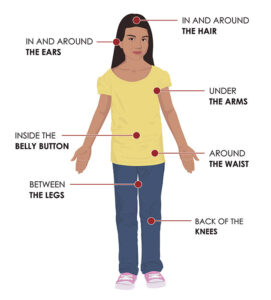Diagnosis
Preventing Lyme Disease
Avoiding tick bites to the best of your ability is the ideal preventative strategy to decrease your chances of contracting Lyme disease or other tick-borne diseases. You can still enjoy time outdoors, but knowing the types of ticks in your area, performing tick checks, and educating yourself on how to remove a tick can go a long way in keeping you and your loved ones safe.

Who is at Risk?
Lyme disease can effect people of any age, gender, or race. It can also effect pets, and many animals that live in the wild. Ticks are most active during the warmer months of the year, but peak at-risk times vary from region to region, based on temperature.
Because of the above listed risk factors, it is generally accepted that people who work seasonal, outdoor jobs are at higher risk of Lyme disease. Additionally, those who participate regularly in outdoor recreational activities are at higher risk.
In terms of demographics, however, it is actually children who are at the highest risk. Based on a CDC study analyzing insurance data, “the peak incidence of diagnoses was among children 5–9 years”. This tends to be because of a lack of preventative measures taken, and can be because a child may not ever know they were bitten. It is up to parents and caretakers to follow all the steps of prevention in order to truly address the highest percentage of Lyme disease cases. The second highest affected demographic was adults aged 49-59. The results for both groups were attributed to increased involvement in recreation compared to other demographics.

Keep in mind, it is possible to develop Lyme disease with or without risk factors stated above. However, the more risk factors, the greater your likelihood of being bitten by an infected tick. This is why Project Lyme has also compiled helpful prevention strategies below.
Prevention Strategies
1. Get To Know Your Outdoor Surroundings
Ticks thrive in a variety of habitats, including the woods, shrublands, tall grass, brushy areas, and piles of leaf litter and twigs. If you’re participating in outdoor activities, like biking, running, hiking, and walking, get to know your surroundings. Take a mental note of areas that might serve as welcome dwelling places for ticks, and steer clear of them as best you can in favor of sticking to the center of paths and trails.
2. Use Tick Repellant on Exposed Skin
The Environmental Protection Agency (EPA) recommends tick repellents containing:
- DEET
- Picaridin
- IR3535
- Oil of Lemon Eucalyptus (OLE)
- Para-menthane-diol (PMD)
- 2-undecanone
Apply the products as directed on the label. Avoid the use of OLE or PMD on children under the age of 3.
*It is important to note that researchers at Harvard Medical School (HMS) recently found that the most common bug spray ingredient, N,N-diethyl-meta-toluamide—better known as DEET—could cause reproductive problems, including infertility and birth defects.
3. Treat Outdoor Clothing and Equipment With Permethrin
The CDC encourages the use of products containing 0.5% permethrin on outdoor clothing, equipment, and gear. Permethrin can be applied to camping equipment, clothing, and footwear to help protect against ticks. Items treated with permethrin last several washings before a reapplication is required. Use according to the instructions on the product. You can also purchase permethrin-treated clothing and gear.
Periodically inspect your clothing and gear for ticks, and promptly remove any you find crawling on you. To kill ticks on clothes, the CDC recommends tumble drying your garments in the dryer on high heat for 10 minutes — more if your clothing is wet or damp. If you need to wash your garments, use hot water.
4. Take a Shower When You Come Inside
To decrease your chances of contracting Lyme disease and other tick-borne diseases, take a shower within two hours of coming indoors, says the CDC. Showering allows unattached ticks to be washed off of the body. It’s also a good time to do a thorough tick check.
5. Perform Head-to-Toe Tick Checks
After you finish taking a shower, perform a full-body, head-to-toe tick check. Immature, nymphal ticks are small, so be sure to pay extra attention to areas that are difficult to see. Handheld or full-length mirrors can assist you in viewing your entire body. Make sure to check:

- On the scalp
- Around the hairline
- In and around the ear area
- Inside the armpits
- In the belly button
- Around the waist
- In the groin and genital region
- Behind the kneecaps
There’s no foolproof plan to ensure you’ll never come in contact with the types of ticks carrying Lyme disease and other infections. But by staying vigilant, learning tick removal strategies, and practicing good tick prevention, you’ll reduce your risks and still have fun outside.


